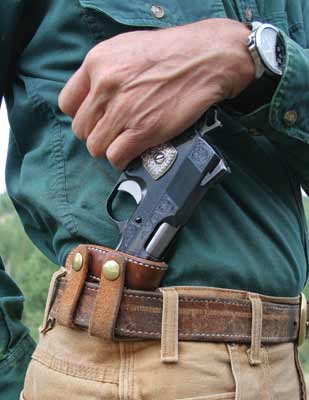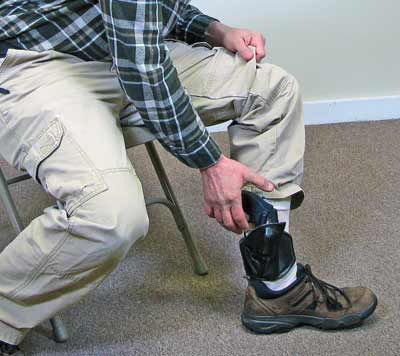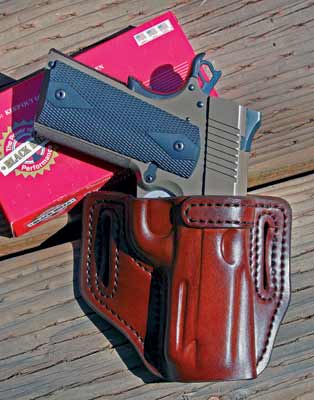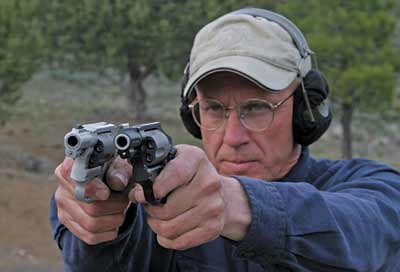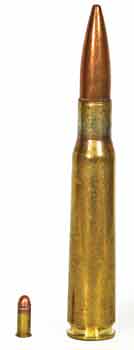
Bad_big
When Is Something Tactically Unsound?
The notion of tactical soundness is one permeating the discipline of defensive handgunning. You’ll hear the soundness of this or that technique or tactic derided all the time with 5-cent words like “that sucks” or “that doesn’t work,” and sometimes with 50-cent words like “that’s tactically unsound.” Everyone has an opinion on the subject, and most aren’t shy about sharing it with you. Yet many of these opinions are themselves unsound — they lack appropriate context and information. I’ll talk about holsters here initially, but they are only as an example of the principle we’re talking about. The principle applies to almost every choice of tactic or technique we have to choose from.
The idea of tactical soundness struck home recently when I read a comment on one of those silly forums, from someone responding to a fellow who was looking for advice on ankle holsters. Several commentators offered their opinion on which ankle holsters they had had good experiences with, but this one left a simple, five word comment: “Ankle holsters are tactically unsound.”
To me, that felt like a kick in the groin.
Because for about 20 years now I had been of the same opinion, even expressing it in print a few times. But for the last year, I’d sometimes been wearing my primary — indeed my only gun — on my ankle. Mr. Succinct Comment reminded me I’d been behaving like a hypocrite, something that made me feel very uncomfortable. This gnawed away at me for a couple of hours, until I realized ankle holsters are not, after all, tactically unsound. Rather, they’re just less sound than some other modes of carry, such as beltline carry.
Does it sound like I’m giving into the ridiculous politically correct speech of our time? Actually, no. Referring to ankle carry as less sound is not the same thing as refusing to call your weak hand “weak” — in fact it is your weak hand. It’s also your clumsy hand and your stupid hand, and it should be called that. Referring to ankle carry as less sound is also not the same thing as referring to me as differentially handsome — there are more accurate words for that. Rather, I refer to ankle carry as less sound because all carry positions have weaknesses and strengths, and some have more of the former or latter than others. In other words, the soundness of a carry position is a spectrum, not a black-and-white proposition.
Is it tactically sound or unsound to draw with a weak hand? Is it wrong to call it your “weak” hand?
If you get your gun into the fight, does that make the draw tactically sound?
The ankle-carried gun can be tactically superior in some situations, such as seated.
Tactical soundness is situation-, context- and alternative-dependent.
The Best?
Indeed, even the best, most preferred carry position (strong-side hip) pretty much sucks. It too is tactically unsound to a large degree. It’s just usually the best of the bad choices we have. Didn’t someone once describe tactics as making the best bad choice? The reason everyone prefers it, if they have a choice, is they can get to their gun more quickly, and under more sets of circumstances.
Measured by the realistic standard of “Can I get to my gun when I really need it?” rather than by the artificial standard of comparing it to other carry methods, belt-carry doesn’t look so good. It takes a trained person about 1.5 seconds to clear a concealment garment, draw their belt-holstered handgun, and get a shot off onto a reasonably sized target. Now compare 1.5 seconds to the time you’ll have in a spontaneous, sudden attack. Also, remember to consider this attack is likely to be very close in.
Consider all these factors, and you realize if attacked typically (that is, without warning and at close distance), you probably won’t have time to access your handgun, even though it’s carried in the very best — the fastest and most reliable location — possible. Suddenly, belt-carry is now “tactically unsound” when viewed under the brutally harsh light of the actual facts of encounters rather than compared to what happens on the range.
In this light, how does belt-carry compare to ankle carry? When evaluated with neurons rather than testosterone, you have to admit each has its advantages and disadvantages. As seen, belt carry is slow to impossible with a typical attack, likewise in many seated positions, particularly when wearing a seat belt in a car.
On the other hand, it’s reasonably fast if you have a little warning of the impending attack, it allows access when you’re moving and it allows access from most positions (on the ground, with the weak hand, etc.). Ankle carry is slow, and suffers from the serious fault that it usually renders you immobile while you access your gun. On the other hand, it’s easier to draw from your ankle rather than your hip when wearing a seat belt or sitting in a tight chair. Take it a step further and compare ankle carry to off-body carry, say, in a bag. While some excellent bags are made offering secure and reasonably fast access to your gun, all bags are slower to draw from than an ankle holster, and they suffer from all the other disadvantages of off-body carry.
The full-size hip-worn pistol sucks in terms of tactical soundness relative to typical self-defense
situations. So don’t get cocky and tell the small-gun, ankle-carrying person they’re engaging in a
tactically unsound practice, when their choice sucks only a little less than the usually recommended one.
Both the smaller J-frame and the full-service-size M&P are tactically sound in
some self-defense situations — and both are not in others.
Well?
So is bag carry tactically unsound? No, and neither is ankle carry or belt carry. It’s certainly true for most people, most of the time: belt carry offers more advantages and fewer disadvantages than the other two methods. It’s equally true that each method has pros and cons. It’s the matching of those tradeoffs to your particular circumstances, like time and place, which determines if a particular mode of carry (and by extension, any decision about equipment, techniques and tactics) is sound or unsound. Carrying a single J-frame on my ankle would indeed have been tactically unsound when I was on-duty as a cop. On the other hand, it’s not so terrible when compared to my other alternative — going unarmed — now that I’m no longer a cop and living in a low-crime environment. Also, since I spend much of my out-of-the-house time driving, it makes even better sense. It might even be less tactically unsound than a belt holster? At least in this situation.
If one J-frame in an ankle holster is less sound tactically, would two
suddenly become more tactically sound?
The difference between a .22 short and .50 is huge. But everyone can agree the .22 is
“enough gun” in some circumstances, while the .50 isn’t. So which is tactically sound,
and which isn’t?
What’s Enough Gun?
Let me give you another example, this one from Michael de Bethencourt’s book, Secrets of the Concealed Carry Snub. In the first few pages of the book he addresses the question: Is the snubby enough gun? Here’s his answer:
“I believe that the honest answer is yes and no. Consider two examples. 1) If, as you pull out of the car dealership with your new hundred thousand dollar sports car, a gentlemen screws a .22 zip-gun into your ear and tells you to get out of the car, you’ll certainly and promptly hop out of that car. Your assessment being that, by your own standard, a .22 caliber zip-gun ‘is enough gun.’ 2) Alternatively if that same gentlemen breaks into your home at 2:00 a.m. and tells you to get out of his way so he can reach your sleeping children, I think we can both agree that he will need to be carrying something substantially larger than a .50 caliber Barrett to get you to just step out of the way. So now, by your different standard, a .50 caliber Barrett isn’t enough gun.”
Michael then goes on to talk about the other component in the situations he describes tending to interact with “how much gun” you have, namely: how much fight there is in both you and your attacker.
But we both make the same point. A tactical decision is only sound or unsound in light of the particular context in which it’s being made, and in comparison to the reasonable alternatives. So let’s not get all huffy calling other people’s decisions about being armed unsound. That decision may be the most reasonable one in their circumstances. Of course, it also may not be. There may have been better decisions they could’ve reasonably made. But constructive criticism should be made acknowledging — and in consideration of — their particular circumstances.
What are your particular circumstances; and what should you be taking into consideration? Weigh the choices of unsound, less sound or simply just adequate for the circumstances. I hope you decide well.
By Ralph Mroz
View This American COP August 2013 Issue Now!

